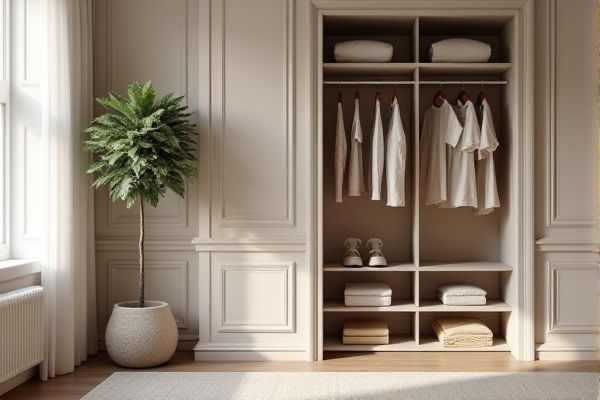
A linen closet is designed for storing towels, sheets, and bedding, featuring shelves optimized for folded fabrics, while a coat closet is typically equipped with a hanging rod to accommodate jackets, coats, and outerwear. Understanding the distinct purposes of these closets can help you maximize your home's storage efficiency; explore the rest of the article to find out which closet suits your needs best.
Table of Comparison
| Feature | Linen Closet | Coat Closet |
|---|---|---|
| Primary Use | Storing bed linens, towels, blankets | Hanging coats, jackets, outerwear |
| Location | Near bathrooms or bedrooms | Near entryways or foyers |
| Shelving | Multiple shelves, often adjustable | Includes hanging rods, sometimes shelves |
| Dimensions | Typically narrow and deep for folded items | Deeper and taller to accommodate hanging garments |
| Climate Control | Dry, well-ventilated to prevent mildew | May include space for boots, umbrellas, and accessories |
| Storage Style | Folded storage on shelves | Hanging storage with hooks or rods |
Introduction: Understanding Linen Closets and Coat Closets
Linen closets store towels, bedsheets, and table linens, optimizing space with shelving tailored for folded fabrics. Coat closets hold jackets, coats, and outerwear, often featuring hanging rods and hooks designed for bulky garments. Your choice between these closets depends on the types of items you need to organize and the available storage space in your home.
Purpose and Functionality
A linen closet is designed for storing towels, sheets, and bedding, keeping your household textiles organized and easily accessible. A coat closet serves a different purpose, providing space for hanging outerwear, hats, and shoes, often located near entryways for convenience. Understanding the distinct functionality helps you optimize storage and maintain an orderly home.
Design and Layout Differences
Linen closets are typically designed with multiple narrow shelves to accommodate folded towels, sheets, and small bathroom essentials, optimizing vertical space for organization and easy access. Coat closets feature wider, sturdier hanging rods and often include shelves or cubbies for shoes and accessories, catering to bulkier outerwear storage requirements. Your choice between the two should consider these design and layout differences to maximize functionality based on the items you need to store.
Storage Needs and Capacity
A linen closet is designed to store flat, lightweight textiles such as towels, sheets, and pillowcases, optimizing vertical space with shallow shelves for easy access and organized stacking. A coat closet typically features deeper shelves or hanging rods to accommodate bulkier items like jackets, coats, and boots, providing ample space for outerwear and seasonal gear. Storage capacity in a linen closet suits folded fabrics, while the coat closet prioritizes vertical height and width to handle larger, hanging garments.
Placement within the Home
Linen closets are typically placed near bathrooms or bedrooms to provide convenient access to towels, sheets, and blankets, optimizing storage for household linens. Coat closets are strategically located near entryways or foyers, offering practical space for storing outerwear, shoes, and accessories as you enter or leave the home. Understanding the distinct placement of each closet helps improve your home's organization and efficiency.
Organization Solutions for Linen Closets
Linen closets require tailored organization solutions such as adjustable shelving, clear storage bins, and labeled containers to keep towels, sheets, and blankets neatly arranged and easily accessible. Unlike coat closets designed for hanging garments and outerwear, linen closets benefit from stackable baskets and dividers to maximize vertical space and prevent clutter. You can enhance functionality by categorizing linens by type and frequency of use, ensuring quick retrieval and maintaining order.
Organization Solutions for Coat Closets
Maximizing organization solutions for coat closets involves incorporating multi-tiered hooks, adjustable shelving, and designated compartments for accessories like scarves, hats, and gloves. Utilizing vertical space with overhead storage bins and installing sturdy rods for various coat lengths enhances functionality in coat closets compared to linen closets. Clear labeling systems and modular storage bins ensure quick access and maintain order in coat closet organization.
Materials and Shelving Options
Linen closets typically feature wire or solid wood shelves designed to support lightweight items like towels and sheets, optimizing breathability to prevent moisture buildup. Coat closets use sturdier materials such as hardwood or metal shelving to accommodate heavy outerwear, incorporating hanging rods and durable hooks for bulkier items. Both closet types may include adjustable shelving systems to customize space efficiently based on storage needs.
Maintenance and Upkeep Tips
Linen closets require regular airing and occasional washing of linens to prevent musty odors and mildew buildup, with shelves cleaned using mild detergent and water to avoid damage. Coat closets benefit from frequent decluttering, with seasonal rotation of outerwear and use of cedar blocks or moisture absorbers to deter pests and moisture. Both closets should have good ventilation and be kept dry to maintain fabric quality and prevent mold growth.
Choosing the Right Closet for Your Space
Linen closets are designed with shelves to store towels, sheets, and other soft goods, maximizing vertical space for easy organization. Coat closets typically feature hanging rods and hooks to accommodate jackets, outerwear, and accessories, making them ideal for entryways or mudrooms. Choosing the right closet for your space depends on your storage needs and the items you want to keep accessible in that specific area.
 homyna.com
homyna.com